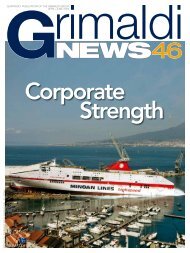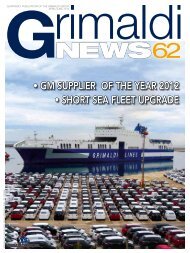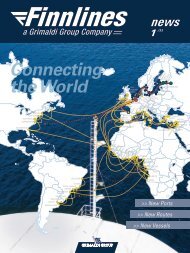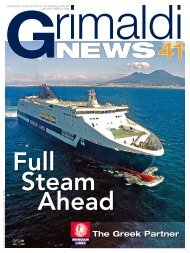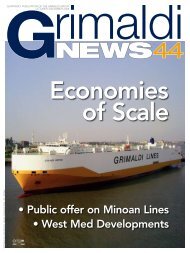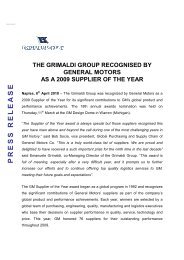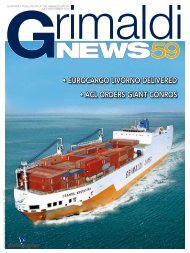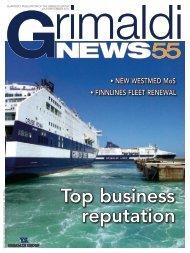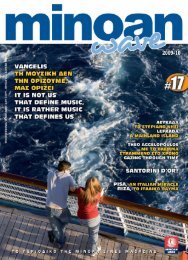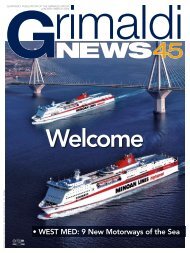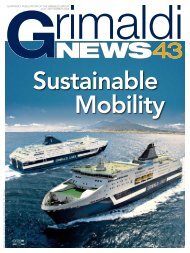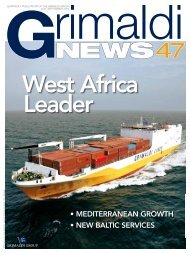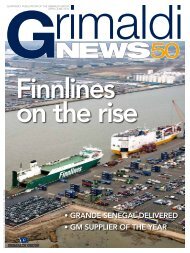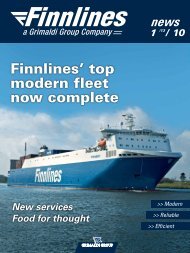NEWS 52 - Grimaldi Group
NEWS 52 - Grimaldi Group
NEWS 52 - Grimaldi Group
Create successful ePaper yourself
Turn your PDF publications into a flip-book with our unique Google optimized e-Paper software.
G r imaldi<br />
<strong>NEWS</strong> <strong>52</strong><br />
QUARTERLY PUBLICATION OF THE GRIMALDI GROUP<br />
october/ December 2010<br />
Tariffa Regime Libero: Poste Italiane SpA - Spedizione in Abbonamento Postale - 70% - DCB Napoli<br />
• The legacy of Guido <strong>Grimaldi</strong><br />
• Vp of Ec Kallas at AET<br />
• Delivery of Eurocargo Malta
The legacy of an Entrepreneur<br />
Guido <strong>Grimaldi</strong>,<br />
an innovator at the helm<br />
of an unrivalled fleet<br />
Guido <strong>Grimaldi</strong>, founder and<br />
Chairman of the <strong>Grimaldi</strong><br />
<strong>Group</strong>, was an extraordinary<br />
innovator and a formidable leader at the<br />
helm of a fleet that has expanded massively<br />
in the last 15 years, the number of<br />
ships having actually doubled in the last<br />
four years.<br />
Guido <strong>Grimaldi</strong> the innovator. Guido<br />
<strong>Grimaldi</strong> died on 5 September this year<br />
after having worked all his life. He embarked<br />
on his long career at the age of 14<br />
when he started attending nautical school<br />
and spending the other 6 months of the<br />
year embarked on ships and undertaking<br />
a range of increasingly demanding duties.<br />
Guido <strong>Grimaldi</strong> receives in 1985 the Honour of Cavaliere del Lavoro, an Italian knighthood for<br />
his services to industry, from the then President Francesco Cossiga (centre) and the Minister<br />
of Industry Renato Altissimo (left).<br />
Throughout his life he was always very receptive<br />
to new ideas in shipping and in the<br />
management of the complex set of activities<br />
associated with shipping companies.<br />
Though not directly involved in the finer<br />
points of their methods of operation, he<br />
always favoured the introduction of highly<br />
complex cutting-edge technologies provided<br />
they would really contribute to the<br />
development of the fleet and the business.<br />
It was his extraordinarily modern and farsighted<br />
vision that recognised the potential<br />
and future importance of Ro-Ro transport<br />
of trucks and trailers. He was the first<br />
to realise that, in the complex system of<br />
logistics, the direct business presence of<br />
the shipowner would increase volumes<br />
of traffic and also bring advantages to the<br />
customer, with control of majority of the<br />
operating cycle. As a result of this forward<br />
thinking, the <strong>Group</strong> now has its own port<br />
terminals and haulage contractors and<br />
also provides the main ancillary services<br />
enabling management of door-to-door<br />
transport for vehicle manufacturers. The<br />
<strong>Grimaldi</strong> <strong>Group</strong> has won recognition and<br />
a series of prestigious awards from some<br />
of the world’s leading auto manufacturers<br />
for the quality of its services. As for the<br />
Motorways of the Sea, once again Guido<br />
<strong>Grimaldi</strong> was quick not only to appreciate<br />
the huge potential of the idea, but also to<br />
invest a great deal of human resources<br />
and capital in it; notably, this included the<br />
construction of four exceptionally large<br />
cruise ferries which were also innovative<br />
in terms of their energy-saving and environmental<br />
compliance features.<br />
One of Guido <strong>Grimaldi</strong>’s undoubted<br />
qualities was his ability to consider other<br />
people’s points of view; he would always<br />
listen carefully to the suggestions of others,<br />
and especially the advice from his<br />
sons Gianluca and Emanuele and sonin-law<br />
Diego Pacella. The willingness to<br />
make way for the ideas of a new generation<br />
while you’re still in your prime working<br />
with great skill and passion – this too<br />
is a sign of a great innovator.<br />
Guido <strong>Grimaldi</strong> the entrepreneur.<br />
Guido <strong>Grimaldi</strong> was a brilliant entrepreneur.<br />
He used to say, “A great fleet is built<br />
2 GNE WS
Left: Guido with his sons Emanuele (standing<br />
on the left), Gianluca (centre) and his<br />
son-in-law Diego Pacella.<br />
Right: Clockwise, the m/vessel “Amelia<br />
<strong>Grimaldi</strong>”, named after the mother of Guido<br />
<strong>Grimaldi</strong> and sister of Achille Lauro. Built in<br />
Venice in 1960, this tanker was the biggest<br />
in Italy in thoses times.<br />
Guido with his uncle Achille Lauro.<br />
patiently, seizing market opportunities<br />
and recognising a good deal before other<br />
people, with courage, money and above<br />
all, putting your heart and soul into it.”<br />
When his uncle Achille Lauro, who was<br />
for many years one of the world’s most<br />
important private shipowners, helped<br />
him purchase his first vessel, one of the<br />
Liberty ships assigned by the United<br />
States to Italy to compensate owners for<br />
tonnage lost in World War II, probably not<br />
even he thought that that ship could be the<br />
foundation stone for a huge <strong>Group</strong> – which<br />
now comprises some eight shipping companies<br />
(4 Italian, 4 foreign) and over 100<br />
vessels. At the start of the venture, in 1947,<br />
the outfit was small: Guido, his brothers<br />
Aldo, Mario and Ugo, and a few hundred<br />
seafarers. Today, there are 3,000 shoreside<br />
personnel and 5,000 shipboard employees.<br />
Guido <strong>Grimaldi</strong> assembled an<br />
excellent team of managers and executives<br />
that enabled the <strong>Group</strong> not only to<br />
come through the recent global economic<br />
unscathed, but to emerge even stronger,<br />
with more human resources and vessels<br />
than ever deployed on the world’s major<br />
trade routes.<br />
The <strong>Group</strong> today. The white “G” on a<br />
blue background forming the company<br />
flag now flies across four continents. In<br />
2009 the ships of the <strong>Group</strong> carried<br />
around 2.7 million passengers, 2.5 million<br />
cars and over 1.3 million trailers, trucks<br />
and containers. Every week <strong>Grimaldi</strong><br />
ships call at over 130 ports in the Mediterranean,<br />
the Baltic, Northern Europe,<br />
West Africa, North & South America, and<br />
the Near East thus contributing to the economic<br />
development of many countries.<br />
Tributes. “A true Renaissance man.”<br />
Among the many tributes paid to Guido<br />
<strong>Grimaldi</strong> this was one of the most indicative.<br />
Another commentator used a quote<br />
from Ernest Hemingway: “Some people<br />
never die. They leave a legacy that lives<br />
forever.” His friend Andy sent the following<br />
message to all the <strong>Group</strong>’s personnel:<br />
“We will do everything possible to ensure<br />
that he is always proud of all of us.” Tributes<br />
to the great man poured in from all<br />
over the world, with many remembrances<br />
of his exceptional generosity and other<br />
special and unique qualities. One person<br />
said he was “a man who could win<br />
without fighting.” The Mayors of Naples<br />
and Salerno and the Presidents of the Regional<br />
and Provincial Governments all<br />
expressed their condolences personally.<br />
The President of Italy, Giorgio Napolitano,<br />
wrote that Guido <strong>Grimaldi</strong> “played an important<br />
role in the Neapolitan economy<br />
and in the development of the country’s<br />
shipping companies; I also remember<br />
his work in Parliament during the Second<br />
Legislature.”<br />
GNE WS<br />
3
Family and human values<br />
Guido,<br />
a generous man and a kind father<br />
What was Guido the private<br />
man like? “Southern Italy’s<br />
answer to Enrico Cuccia”, as<br />
he was sometimes called? Methodical, a<br />
solitary person of fixed habits? This description<br />
may be true to some extent, if<br />
we consider the great entrepreneur, but<br />
it’s well wide of the mark if we look at the<br />
man that emerges from the many anecdotes<br />
and stories told by his wife Paola<br />
and daughter Consuelo. And, though he<br />
always kept a low profile, Guido <strong>Grimaldi</strong><br />
had a wonderful sense of humour; he<br />
once wrote a thank-you note to the Mattozzi<br />
Family, who owned the waterfront<br />
restaurant where he would always eat at<br />
lunchtime, phrased as follows: “Thanks<br />
for letting me survive for so long, over<br />
50 years of patronage….” His laugh was<br />
infectious, he was a wonderful raconteur<br />
and all who knew him found Guido a very<br />
engaging person.<br />
Guido was a tough man, but gentle at the<br />
same time. He was a strict father, but only<br />
so as to prepare his children to deal with<br />
life. He had very high moral standards<br />
and was extremely altruistic, especially<br />
with regard to the less fortunate. He was a<br />
very learned man with a great love of art,<br />
history, archaeology and mythology. He<br />
had a great respect for nature and was<br />
something of an aesthete. “He had an<br />
eye for the women too,” says Paola with<br />
a smile. “Especially redheads; he used to<br />
say that between a portrait of a cardinal<br />
by Titian and a less valuable painting of<br />
a beautiful woman he’d choose the latter.”<br />
Though Consuelo quickly adds, “OK,<br />
but he always said that the best deal he<br />
ever did in his life was when he married<br />
Mum, not just because of her looks, but<br />
because she was well-read, did lots of<br />
voluntary and social work, and appreci-<br />
Above: Guido with his wife Paola and his five children: Consuelo, Cosimo, Gianluca, Amelia<br />
and Emanuele.<br />
Below: The wedding of Guido <strong>Grimaldi</strong> and Paola Arcidiacono back in 1954.<br />
4 GNE WS
Guido while visiting one of the vessels<br />
of the <strong>Group</strong> together with his son<br />
Emanuele and grandsons Mario and<br />
Guido Jr.<br />
Below: Guido with his wife Paola and his<br />
grandchildren.<br />
ated the importance of family life. In fact<br />
he let her decide when it came to bringing<br />
up the children, running the house<br />
and choosing friends.”<br />
The young Guido was under the spell of<br />
his uncle Achille Lauro and his largerthan-life<br />
personality. He was the favourite<br />
nephew and never failed to go and<br />
greet his uncle each morning. It was<br />
actually through Achille that Guido met<br />
Paola, since her parents were friends of<br />
the Neapolitan icon known as ‘O Comandante.<br />
It was love at first sight and when<br />
they got married Guido’s best man was<br />
his uncle Achille. By this time Guido was<br />
already a Monarchist Party MP. The wedding<br />
reception was held at the Grand Hotel<br />
in Rome and, while friends and relatives<br />
were still celebrating, Uncle Achille<br />
forced the groom to leave the hotel so<br />
that he could round up some other Members<br />
of Parliament and canvass their support<br />
in order to avoid a party split. “I don’t<br />
know any other woman who was ‘abandoned’<br />
on her wedding day,” Paola jokes,<br />
“but he did come back eventually. By then<br />
it was late though, so we had to change<br />
plans and go to the Palazzo della Fonte<br />
in Fiuggi where they knew us. When we<br />
got there the receptionist eyed us suspiciously<br />
so Guido waved our marriage<br />
certificate at him and said, ‘I know what<br />
you were thinking!’ The family was the<br />
centre of the universe for him. He loved<br />
children, not just his own, but all children<br />
because they’re young and innocent.”<br />
“In summer in Ischia,” Consuelo recalls,<br />
“you would find him on the beach digging<br />
holes and making sandcastles, surrounded<br />
by dozens of kids. Children loved him.<br />
In the last few days before he died, his<br />
face would only light up when Guidolino<br />
came into his room – Guidolino is Amelia’s<br />
son and he’s the baby of the family.<br />
Guido was incredibly fit for his age; at<br />
almost 80 he was still climbing fig trees<br />
and could swim faster and further than<br />
Manuel, who’s a strong swimmer himself.”<br />
Mother and daughter are full of<br />
stories. “Dad was very absent-minded,”<br />
Consuelo remembers, “and while he was<br />
driving he used to read the newspaper,<br />
eat ice creams, get distracted by goodlooking<br />
women and so on. Anyway, one<br />
day, while he was out in his car he ran<br />
into a little old man. Luckily it wasn’t serious<br />
but my father went to see him at the<br />
Pellegrini Hospital and this fellow’s wife<br />
said to Dad, ‘Mr <strong>Grimaldi</strong>, he’s the only<br />
husband I’ve got. Did you want to leave<br />
me on my own without even him?’ Dad<br />
thought this was very funny and ended<br />
up paying the old man handsomely in<br />
compensation.”<br />
“He always believed you could and<br />
should find a solution to any problem. I<br />
never ever heard him say, ‘I’m too tired’<br />
or ‘I can’t be bothered’. He was an optimist<br />
by nature and I only saw him really<br />
upset once,” Paola adds affectionately.<br />
“That was when Luca was kidnapped<br />
and we still had no word after paying the<br />
second instalment of the ransom. Guido<br />
thought they’d killed Luca. Thank God<br />
they hadn’t and it all turned out for the<br />
best.”<br />
“In the last few years of his life,” Paola<br />
concludes, “he developed something<br />
of a sweet tooth, but he didn’t like to admit<br />
it because he considered it a sign of<br />
weakness. And he also became a bit vain.<br />
After decades of blue and grey suits he<br />
discovered a liking for lighter colours,<br />
especially lavender-grey jackets after his<br />
children and friends told him that shade<br />
really suited him.”<br />
GNE WS<br />
5
Xxxxxxxxxxx<br />
Editorial<br />
Time for Europe to act<br />
Contents<br />
2 Guido <strong>Grimaldi</strong>, an innovator<br />
4 A generous man and<br />
a kind father<br />
7 “Grande Togo” christened,<br />
“Eurocargo Genova” delivered<br />
8 Siim Kalls at AET<br />
9 New era in Ancona‐Greece<br />
maritime links<br />
10 New Livorno-Catania -Malta<br />
service launched<br />
Irish Minister of Defence<br />
visits the “Grande Senegal”<br />
11 <strong>Grimaldi</strong> receives the<br />
Ford Q1 certification<br />
12 Honda recognises ACL<br />
Beninese Minister visits<br />
the m/v Grande Benin<br />
13 News<br />
14 Agent List<br />
15 Schedules<br />
- Mediterranean Short Sea Network<br />
- Finnlines (Baltic & North Sea)<br />
- Atlantic Network<br />
- ACL<br />
- Euro Med Network<br />
G r imaldi<br />
NE WS<br />
Direttore Responsabile / Editor in Chief<br />
Luciano Bosso<br />
Progetto grafico /Graphic design<br />
Marco Di Lorenzo<br />
Pubblicazione trimestrale<br />
Quarterly publication<br />
Reg. Trib. Napoli n. 5150 del 26/9/2000<br />
Stampa / Print: ROSSI srl - Nola (Napoli)<br />
Circulation 34,500 copies<br />
Printed on 1 st October<br />
GRIMALDI GROUP<br />
Via Marchese Campodisola, 13<br />
6 GNE WS80133 NAPOLI (Italy)<br />
<strong>Grimaldi</strong> News can be seen on<br />
line on www.grimaldi.napoli.it<br />
Irresponsible shipowners have been a danger to life, limb and property ever since man<br />
first took to the sea in ships, but rarely can the dangers posed by the sub-standard owner<br />
and his sub-standard vessel have been so various or threatening as they are today.<br />
As world trade has expanded, so too has the world fleet. The boom that came before the<br />
crash provided an opportunity for fleet replacement and many far-sighted, responsible owners<br />
took the opportunity offered by surging profits to order new ships and despatch older<br />
vessels to the breakers’ yard.<br />
Yet many did not. Even now, the world’s oceans are full of vessels in excess of 30 years of<br />
age, or even 40, which is surely well past any reasonable retirement age. While the age of<br />
a ship may not correlate exactly with its quality, it is also true that, as vessels age, necessary<br />
maintenance becomes more critical and more costly. Some owners are simply not<br />
prepared for the investment, whether in money, time or organisation, that keeping their ship<br />
safe entails.<br />
And yet the need to focus on the structural integrity of the fleet has never been more acute.<br />
As shipowners, we have a responsibility to our crews, who trust us to maintain, at a very<br />
minimum, the standards of training and vessel quality required under international regulation.<br />
This need is pressing at a time when attracting bright young people to our industry<br />
is increasingly difficult. For those of us who carry passengers, there is a similar need to<br />
ensure we meet our customers’ expectation that our ships are state-of-the-art in every way.<br />
As citizens, we also have a responsibility to the marine environment, and to the children<br />
and grandchildren who will inherit the seas we leave behind. Of all the transport modes,<br />
shipping may be the most environmentally friendly, but that does not mean we have done<br />
all that we can do.<br />
As we debate new emissions standards and work to develop and implement energy efficiencies<br />
both onboard and ashore, the continuing employment of old, sub-standard tonnage<br />
is both an affront to those of us fighting to make a difference, and paying the cost,<br />
and a blow to our chances of reducing shipping’s impact on the environment.<br />
At <strong>Grimaldi</strong>, we have been fighting the good fight for some time, working to cut energy use<br />
across the company, collaborating on research projects to develop new, environmentally<br />
beneficial technologies, and ordering state-of-the-art new ships to replace older vessels.<br />
As a result, the 87 ships in the <strong>Grimaldi</strong> fleet have an average age of just 9.3 years, below<br />
the average age of the european (about ten years) and world fleet (12 years). With 21 ships<br />
delivered over the last five years and 17 more to come, that will drop further, improving the<br />
company’s performance and reinforcing its reputation as a careful steward of our customers,<br />
our seafarers and the environment in which we operate.<br />
Yet there is only so much that we and other responsible shipowners and operators can do<br />
to make a difference if others continue to operate old and sub-standard tonnage with impunity.<br />
That is why we are calling for European regulation that would mandate the scrapping<br />
of all vessels over 30 years of age, effectively driving them from our ports and waters.<br />
Such regulation, strictly enforced with the assistance of classification societies, flag states<br />
and port states, will not only improve standards of safety and remove a significant threat to<br />
the environment but help rebalance markets in which the supply of ships far outstrips demand,<br />
endangering the economic survival of many sound companies. The benefits of such<br />
a policy are many, the down side negligible. The time to act is now.
Fleet development<br />
“Grande Togo” christened,<br />
“Eurocargo Genova” delivered<br />
In the last few months the newbuilding<br />
programme of the <strong>Grimaldi</strong> <strong>Group</strong><br />
has seen the launch of a new vessel<br />
and the delivery of another one. In fact,<br />
on the 1 st of August the “Grande Togo”<br />
was launched at the Uljanik shipyard<br />
(Croatia) while the “Eurocargo Malta”<br />
was delivered on the 24 th of the same<br />
month from the Korean shipyard of Hyundai<br />
Mipo in Ulsan.<br />
The launching of the ro/ro-container<br />
vessel “Grande Togo” was held at the<br />
Scoglio Olivi shipyard, and the Godmother<br />
of the vessel was young Nina Sebastijan,<br />
a 2 nd year student of the primary<br />
school of Monteparadiso. The “Grande<br />
Togo”, the sixth of a series of seven units<br />
commissioned by the <strong>Group</strong>, has a gross<br />
tonnage of 26,650 tonnes, a length of 210<br />
metres, a width of 32 metres and a height<br />
of 21.5 metres. Thanks to her 12 decks,<br />
two of which are hoistable, she is able to<br />
transport 3,890 cars and 1,360 containers<br />
at a maximum speed of 21.9 knots.<br />
The vessel will be deployed on the West<br />
Africa route, on the Southern Express<br />
Service, linking North Europe to the<br />
ports of Casablanca, Dakar, Lome, Luanda,<br />
Lobito, Douala and Abidjan.<br />
The “Eurocargo Malta”, sistership of the<br />
“Eurocargo Genova”, was delivered on<br />
the 24 th of August and is the second of<br />
eight units ordered from the Korean<br />
shipyard of Hyunday Mipo in Ulsan.<br />
Measuring 200 metres long, 26.5 metres<br />
wide and with a gross tonnage of<br />
32,644 tonnes, she can transport 3,900<br />
linear metres of rolling cargo (cars, vans,<br />
trucks, trailers, etc.) at a service speed<br />
of 23 knots. The “Eurocargo Malta” is<br />
classified by the Italian Ship Classification<br />
society (RINA) and has a ramp capable<br />
of loading up to 120 tonnes. The<br />
vessel has ten decks, two of which are<br />
hoistable. She joined the “Eurocargo<br />
Genova” on the short sea route linking<br />
the port of Genoa to Livorno, Catania<br />
and Malta.<br />
GNE WS<br />
7
Events<br />
Siim Kalls at AET<br />
The Vice President of the European<br />
Commission and Commissioner for<br />
Transport visited the <strong>Group</strong>’s terminal<br />
in Antwerp in September<br />
On the 13 th of September the<br />
Vice President of the European<br />
Commission and Commissioner<br />
for Transport Siim Kallas visited<br />
Antwerp Euroterminal (AET) with a delegation<br />
comprised of Etienne Schouppe,<br />
Belgian Secretary of State for Transport,<br />
Frans van Rompuy, Director General of<br />
the Belgian Ministry of Transport, Eddy<br />
Bruyninckx, Managing Director of the<br />
Antwerp Port Authority, Alfons Guinier,<br />
Secretary General of ECSA (European<br />
Community Shipowners' Associations),<br />
Patrick Verhoeven, Secretary General of<br />
ESPO (European Sea Ports Organisation)<br />
and various officials from DG Move.<br />
The Commissioner and his delegation<br />
were received by Emanuele <strong>Grimaldi</strong>,<br />
co-managing director of the <strong>Grimaldi</strong><br />
<strong>Group</strong>, Marc Ivens, managing director<br />
of AET and Mexiconatie (shareholder together<br />
with the <strong>Grimaldi</strong> <strong>Group</strong> in Antwerp<br />
Euroterminal) and by Francesco<br />
Costa, Chef Operations Officers of AET.<br />
A short tour of the facilities was organised,<br />
illustrating the logistics and multimodal<br />
operations at the terminal, particularly<br />
the connection between the terminal<br />
and the European road, rail and inland<br />
waterways network. The tour was followed<br />
by a visit and cocktail party held<br />
onboard the Pure Car & Truck Carrier<br />
Grande Colonia, currently deployed by<br />
the <strong>Grimaldi</strong> <strong>Group</strong> on the Euro Aegean<br />
Service, linking North Europe to various<br />
Mediterranean ports.<br />
Currently, AET manages a terminal on<br />
the Left Bank of the port of Antwerp with<br />
a surface of one million m2, a quay length<br />
of 1,600 metres and storage facilities for<br />
any type of rolling equipment, containers<br />
and unitised general cargo. Today, the<br />
terminal is being used as a hub by the<br />
various ro/ro-container services of the<br />
<strong>Grimaldi</strong> <strong>Group</strong> to the Mediterranean,<br />
West Africa and South America as well<br />
as by Finnlines (a <strong>Grimaldi</strong> <strong>Group</strong> company)<br />
for their services to Spain and the<br />
Baltic Sea.<br />
Top: From left to right: Siim Kallas, Emanuele<br />
<strong>Grimaldi</strong> and Etienne Schouppe.<br />
Below left: Siim Kallas while visiting the m/<br />
vessel Grande Colonia accompanied by<br />
Emanuele <strong>Grimaldi</strong> and the Belgian Secretary<br />
of State for Transport Etienne Schouppe.<br />
Below right: Emanuele <strong>Grimaldi</strong>, Eddy Bruyninckx<br />
(Managing Director of the Antwerp Port<br />
Authority), Siim Kallas and Etienne Schouppe.<br />
8 GNE WS
Mediterranean routes<br />
New era in Ancona‐Greece<br />
maritime links<br />
“Cruise Europa” and “Cruise<br />
Olympia” offer unrivalled<br />
services both for freight<br />
and passengers<br />
Minoan Lines, a <strong>Grimaldi</strong><br />
<strong>Group</strong> company, is experiencing<br />
a significant increase<br />
in the volume of freight and passengers<br />
transported on the daily service it operates<br />
between the Italian port of Ancona<br />
and the Greek ports of Igoumenitsa and<br />
Patras.<br />
In spite of the crisis which is heavily affecting<br />
the Greek economy, prospects<br />
are very encouraging for this year’s<br />
summer season where Minoan Lines<br />
achieved unprecedented records in the<br />
history of the maritime links between<br />
Italy and Greece by transporting over<br />
2,800 passengers on many sailings between<br />
Patras, Igoumenitsa and Ancona.<br />
The secret of this success is in the deployment<br />
on the service of the twin<br />
vessels “Cruise Europa” and “Cruise<br />
Olympia”, last in a series of four cruise<br />
ferries built by the Fincantieri shipyards.<br />
Delivered respectively in October 2009<br />
and June 2010, both units have marked<br />
the start of a new era in the maritime links<br />
between Italy and Greece, by ensuring a<br />
high standard of service both for freight<br />
Ancona<br />
Igoumenitsa<br />
Patras<br />
and passengers.<br />
The “Cruise Olympia” and “Cruise Europa”<br />
are the biggest cruise ferries in<br />
the Mediterranean. With a length of 225<br />
metres, a width of 31 metres, a gross tonnage<br />
of 54,310 tonnes and a speed of 28<br />
knots, they perform the journey between<br />
Ancona and Patras (via Igoumenitsa) in<br />
only 22 hours.<br />
Both units have an unbeatable capacity<br />
for both passengers and freight, allowing<br />
Minoan Lines to offer extremely competitive<br />
freight rates and fares. The freight<br />
capacity of each vessel is 3,000 linear<br />
metres of rolling units (trucks, trailers,<br />
coaches and vans) and 250 passenger<br />
cars which means offering an unlimited<br />
space to trucking companies even during<br />
the summer months when the number<br />
of passengers increases dramatically<br />
and usually competes with freight for<br />
space onboard.<br />
With regard to passengers, both the<br />
“Cruise Europa” and the “Cruise Olympia”<br />
can transport up to 3,000 passengers<br />
who can be accommodated in 413 comfortable<br />
cabins (18 of which are owner’s<br />
suites and 50 junior suites) in addition to<br />
548 reclining seats (114 of which are firstclass).<br />
They both offer onboard services<br />
similar to those of cruiseships: an à la<br />
carte restaurant, bars, casino, gym, a<br />
conference hall, wellness area, swimming<br />
pool, two lounges for truck drivers,<br />
disco, internet point, and children’s areas.<br />
GNE WS<br />
9
Mediterranean routes<br />
New Livorno-Catania-Malta<br />
service launched<br />
The <strong>Grimaldi</strong> <strong>Group</strong> continues its policy<br />
of strengthening and expanding<br />
its activities in the Western Mediterranean<br />
by launching another maritime<br />
link. As from the 25 th of September, a<br />
new regular service for rolling freight<br />
between the ports of Malta, Catania and<br />
Livorno (the main port of Tuscany), has<br />
become operational.<br />
The new line has a twice-a-week frequency,<br />
with departures from Livorno<br />
to Catania on Thursdays and Sundays,<br />
and to Malta on Mondays and Thursdays.<br />
Departures from Malta to Livorno<br />
are on Mondays and Saturdays, while<br />
from Catania to Livorno on Tuesdays<br />
and Saturdays. The new call at the port<br />
of Livorno has been integrated into the<br />
regular service currently offered by the<br />
<strong>Group</strong> between the ports of Genoa, Catania<br />
and Malta.<br />
Valencia<br />
Barcelona<br />
Genoa<br />
Porto Torres<br />
Irish Minister of Defence<br />
visits the “Grande Senegal”<br />
Cagliari<br />
Tunis<br />
Al Khoms<br />
Livorno<br />
Civitavecchia<br />
Palermo<br />
Trapani<br />
Salerno<br />
Catania<br />
Malta<br />
Patras<br />
Two sisterships are operating on this new<br />
connection: the “Eurocargo Malta” and<br />
“Eurocargo Genoa”, the youngest units<br />
of the <strong>Group</strong>’s fleet. Delivered by the<br />
Hyundai Mipo shipbuilders last summer,<br />
both units can carry about 4,000 linear<br />
metres of rolling cargo, equivalent to 280<br />
trailers, at a service speed of 23 knots.<br />
With the launch of these new maritime<br />
links the <strong>Grimaldi</strong> <strong>Group</strong> further<br />
strengthens its Motorways of the Sea<br />
network and confirms its commitment<br />
to provide an extensive range of direct<br />
connections for the transport of rolling<br />
freight between Northern Italy (Genoa),<br />
Central Italy (Civitavecchia), Sicily (Catania)<br />
and, via transhipment, to the markets<br />
of Greece, Libya and Spain.<br />
Corinth<br />
On the 26 th of July 2010 the Irish<br />
Minister for Defence, Tony Killeen<br />
TD, accompanied by Defence<br />
Forces Chief of Staff, Lieutenant<br />
General Sean McCann, were in the port<br />
of Dublin to oversee to the discharge<br />
operations of the Defence Forces equipment<br />
from the “Grande Senegal”, which<br />
had transported the equipment from<br />
Chad.<br />
The arrival in Dublin represents the final<br />
phase of a major logistics operation<br />
which began in April, following the Irish<br />
Government's decision to commence the<br />
withdrawal of its troops from Chad.<br />
The operation began with the dismantling<br />
of Defence Forces facilities in Goz<br />
Beida, Eastern Chad. Cargo was moved<br />
about 900 km across the desert and<br />
then sensitive cargo was flown to the<br />
Cameroonese Port of Douala, while the<br />
remaining equipment of the Defence<br />
Forces was moved 900 km by road and<br />
then onward by rail to the port of Douala.<br />
On the 13th of July over 3,000 tonnes<br />
of equipment was loaded on board the<br />
“Grande Senegal”, from Douala to Dublin;<br />
the equipment included 208 TEU containers<br />
and 75 trucks, 4x4 and armoured<br />
vehicles, with an assortment of trailers,<br />
fuel bowsers and other wheeled units.<br />
Chad which is located in Central Africa,<br />
is approximately twice the size of France,<br />
with little or no infrastructure.<br />
The “Grande Senegal”, with a length of<br />
210.92 metres, a width of 32.26 metres<br />
and a gross tonnage of 47,300 tonnes, is<br />
able to load 2,000 cars/vans, 2,000 linear<br />
metres of rolling cargo and 800 TEU. It is<br />
deployed on the Southern Express Service<br />
linking North Europe to the southern<br />
ports of West Africa and the Lisbon Express<br />
Service, linking Portugal with West<br />
Africa.<br />
10 GNE WS
Achievements<br />
<strong>Grimaldi</strong> receives the Ford<br />
Q1 certification for the 10 th<br />
consecutive year<br />
The automotive giant recognises the <strong>Group</strong>’s excellence and<br />
quality of services<br />
For the 10 th year in a row the automotive<br />
giant Ford granted the<br />
<strong>Grimaldi</strong> <strong>Group</strong> the Ford Q1 quality<br />
certification, the highest award granted<br />
by the automotive firm to its suppliers.<br />
The <strong>Group</strong> was the first European shipping<br />
company in getting this certificate,<br />
in 1999.<br />
The Ford Motor Company requires high<br />
quality standards from its various suppliers.<br />
One of these requirements is determined<br />
by the QOS (Quality Operating<br />
System) tool that each supplier must use<br />
to achieve the Ford certification, a recognition<br />
of excellence and quality.<br />
The QOS provides a number of parameters,<br />
metrics and systems of work involving<br />
the entire team, including the<br />
Management. Subsequently, on an annual<br />
basis, Ford audits its suppliers to<br />
establish if they really set working procedures<br />
in accordance with the levels of<br />
Ford's demand.<br />
According to Capt. Giovanni Fusco,<br />
Quality and Damage Prevention Manager,<br />
"in 1996 the <strong>Group</strong> started to integrate<br />
the QOS tool in our quality system involving<br />
all the equipment (ships, terminals,<br />
employees ...) and in 1999 we succeeded<br />
in being credited with the Q1. "<br />
Capt Fusco declared that the 10 th Q1 certification<br />
is a "great satisfaction, not only<br />
because it represents the maintenance of<br />
excellence, but also because it is a commitment<br />
to continuous improvement."<br />
To perform the audit for the Q1 certification,<br />
Ford divides the activities of their<br />
suppliers into four main modules, with<br />
their subdivisions, which will be evaluated<br />
one by one and rated on the basis<br />
of a maximum score. The four modules<br />
quoted refer to the quality (performance<br />
quality, process improvement, customer<br />
focus); delivery (performance in transit),<br />
engineering (equipment, technical and<br />
innovation novice) and the commercial<br />
module (productivity, development prices,<br />
Management ability, etc.).<br />
GNE WS11
Achievements<br />
American Honda recognises ACL<br />
with Premier Partner Award<br />
Atlantic Container Line (ACL), a<br />
<strong>Grimaldi</strong> <strong>Group</strong> company, was recognised<br />
as a top supplier by American<br />
Honda Motor Co.<br />
President & CEO Tetsuo Iwamura presented<br />
the company’s Premier Partner<br />
Award to ACL for excellence in international<br />
transportation between North<br />
America and Europe. ACL was one of<br />
15 award recipients selected from 45 suppliers<br />
nominated by American Honda<br />
associates nationwide. William Kearns,<br />
Executive Vice-President for ACL, stated:<br />
"It is an honour and a distinct privilege<br />
for ACL to receive this prestigious award<br />
from American Honda. We are very fortunate<br />
to have earned their trust and<br />
support the past 20 years in providing<br />
transportation services for their transatlantic<br />
shipments."<br />
The Premier Partner Awards were established<br />
in 1998 to recognize suppliers who<br />
embrace American Honda’s philosophy<br />
of exceeding customer expectations.<br />
This year’s award winners represent<br />
excellence in a variety of industries including<br />
logistics, printing, marketing,<br />
packaging and much more.<br />
“Today we acknowledge an outstanding<br />
group of suppliers who embody Honda’s<br />
philosophy of delivering the highest possible<br />
value to our customers through<br />
quality products and customer service,”<br />
said Gary Kessler, American Honda’s<br />
senior vice president of Human Resources,<br />
Administration and Corporate Affairs.<br />
“The support of these suppliers is critical<br />
to the success of American Honda and<br />
we are honoured to recognize them for<br />
their exceptional contributions.”<br />
Since 1967, ACL has been a specialised<br />
carrier of containers, project and<br />
oversized cargo, heavy equipment and<br />
vehicles with the world’s largest combination<br />
Ro-Ro/containerships. ACL offers<br />
five transatlantic sailings each week as<br />
well as container, Ro-Ro and breakbulk<br />
service between North America and<br />
West Africa and oversized service to the<br />
Mediterranean, Middle East, Australia,<br />
South America, Far East and South Africa.<br />
Beninese Minister of Maritime<br />
Transport visits the “Grande Benin”<br />
From left to right:<br />
Philip W. Byrne, Area Sales Manager, Chicago<br />
ACL with Tetsuo Iwamura, President of<br />
Honda North America, and William F. Kearns<br />
Executive Vice President of ACL<br />
Last 3 rd of August the m/vessel Grande<br />
Benin was welcomed by a high-ranked<br />
delegation of the Beninese Government at<br />
the port of Cotonou.<br />
The welcoming ceremony was held on<br />
board the vessel and was attended by the<br />
Minister of Maritime Transport Issa Badarou<br />
Soulé, the king of the Yoruba Tribe Onikoyi,<br />
the Italian consul Vitaliano Gobbo<br />
and many local authorities and customers.<br />
After the welcoming speech held by the<br />
master of the vessel Giovan Battista Virzì,<br />
the Managing Director of <strong>Grimaldi</strong> Benin<br />
Giuliano Petrellese underlined the presence<br />
of the <strong>Group</strong> in Benin for the last 20<br />
years, in which the <strong>Group</strong> counts about<br />
2 million vehicles discharged and the<br />
number of yearly calls at Cotonou exceeding<br />
100.<br />
During the ceremony, the Minister Issa<br />
Badarou Soulé underlined not only the importance<br />
of having the vessel named after<br />
the name of the host country, but also the<br />
contribute that the ro-ro/container vessel<br />
Grande Benin (built in 2009) will give to<br />
the trade of Benin, bringing welfare to the<br />
country. He finally wished the cooperation<br />
between the <strong>Grimaldi</strong> <strong>Group</strong> and the<br />
country would continue in a future reciprocal<br />
partnership.<br />
After the blessing of king Onikoyi, who<br />
personally thanked Gianluca <strong>Grimaldi</strong>,<br />
co-managing director of the <strong>Group</strong>, and<br />
wished the vessel favorable winds through<br />
out oceans, the ceremony ended with an<br />
exchange of gifts and a visit of the vessel.<br />
12 GNE WS
Minoan<br />
carries generator<br />
to Greece<br />
O<br />
n the 21<br />
st<br />
of August Minoan Lines shipped a<br />
generator from Venice to Igoumenitsa on board<br />
the “Olympia Palace”: the abnormal cargo weighed<br />
110 tonnes, had an height of 4 metres, a length of<br />
34.5 metres with a width of 3.85 metres.<br />
<strong>NEWS</strong><br />
Museum quality<br />
handling for vintage trolley<br />
ACL transported a 1912 trolley car from New York to Gothenburg,<br />
Sweden, on board the “Atlantic Concert”. The No. 71 tram was<br />
part of a collection at the Branford Electric Railway in East Haven,<br />
Connecticut, which ran a trolley route from 1907 through 1937. The<br />
trolley was 10 metres long, 1.8 metres wide, 3.8 metres high and had<br />
a weight of 13 tonnes. Upon arrival at Gothenburg the trolley was<br />
safely discharged to the Swedish Tramway Society Museum for display.<br />
Rail wagon<br />
from the UK to Italy<br />
On the 15 th of September a rail wagon was shipped on board<br />
the “Gran Bretagna” deployed on the Euromed service<br />
route, from the port of Southampton to Salerno. The wagon, with<br />
a length of 24.5 metres, a width of 2.74 metres and a height of<br />
4.7 metres, weighed 73 tonnes and was loaded on a 1x 80’ mafi.<br />
Old London busses sail<br />
onto “Atlantic Cartier” after<br />
50-year round trip<br />
ACL recently transported a convoy of 11 antique double-decker busses<br />
from the port of Halifax, Nova Scotia, to Liverpool, England, on board<br />
its RoRo/Containership “Atlantic Cartier”.<br />
The fleet of former London Transport busses made one of their longest<br />
scheduled trips ever: the classic AEC Routemaster and Regent doubledeckers<br />
returned to the UK after operating at Prince Edward Island, Nova<br />
Scotia, for cruise line passenger tours, since the early 1960s.<br />
On the 11th of May the busses were quickly discharged in Liverpool via the<br />
vessel’s 420-metric tonne capacity stern ramp; they were then stored at<br />
the Port of Liverpool prior to being transported to Essex where the busses<br />
will become part of the Epping Ongar Railway Heritage Service.<br />
GNE WS13



